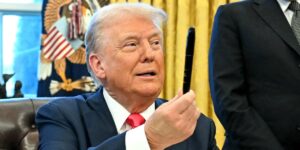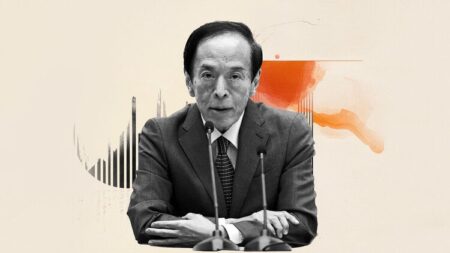- Gold price struggles to capitalize on its intraday move higher beyond the $3,400 mark.
- The Fed’s hawkish pause underpins the USD and caps the non-yielding yellow metal.
- A positive risk tone further weighs on the XAU/USD pair ahead of Trump’s presser.
Gold price (XAU/USD) attracts some sellers following an Asian session uptick to the $3,414-3,415 area and retreats to the lower end of its daily trading range in the last hour. The Federal Reserve’s (Fed) hawkish pause on Wednesday keeps a floor on the US Treasury bond yields and the US Dollar (USD), which, along with a positive risk tone, acts as a headwind for the non-yielding yellow metal. That said, a combination of factors warrants some caution before positioning for an extension of the commodity’s retracement slide from a two-week high touched on Tuesday.
US President Donald Trump tempered hopes for a quick resolution to the US-China trade war by saying that he is in no real hurry to sign any deals. Furthermore, persistent geopolitical risks stemming from the Russia-Ukraine war, conflicts in the Middle East, and a dangerous military confrontation on the India-Pakistan border should support the safe-haven Gold price. Traders also seem reluctant ahead of Trump’s press conference at 14:00 GMT.
Daily Digest Market Movers: Gold price bulls seem reluctant amid positive risk tone, ahead of Trump’s press conference
- US President Donald Trump said on Wednesday that he was not open to lowering the 145% tariffs imposed on China in order to encourage trade-war negotiations. This keeps a lid on the optimism led by the announcement of US-China trade talks later this week and lends some support to the safe-haven Gold price.
- Airports were shut down across Moscow amid a massive Ukrainian drone attack ahead of Russian President Vladimir Putin’s unilaterally announced three-day truce. Furthermore, Ukraine said that Russia had launched guided bombs nearly three hours after the ceasefire came into force earlier this Thursday.
- Meanwhile, the Israeli military said that it had fully disabled Yemen’s main airport in the capital, Sanaa, which is controlled by the Houthis. In response, a member of the Houthis’ top political body said that the response to Israel’s attacks is coming. This keeps geopolitical risks in play and further underpins the XAU/USD pair.
- The Federal Reserve, as was widely expected, held its key interest rate unchanged in a range between 4.25%-4.5% at the end of a two-day monetary policy meeting on Wednesday. In the accompanying statement, the US central bank noted that the uncertainty about the economic outlook has increased further.
- In the post-meeting press conference, Fed Chair Jerome Powell also noted that there is a great deal of uncertainty about tariffs and said that the right thing to do is wait for further clarity. This suggests that the US central bank is not leaning toward cutting rates anytime soon, though it failed to impress the US Dollar bulls.
- Trump said on Truth Social that he will announce a major trade deal, the first of many, with representatives of a big and highly respected country on Thursday. This remains supportive of a generally positive risk tone around the equity markets and could act as a headwind for the precious metal.
- The market focus will remain glued to Trump’s press conference at 14 GMT in the Oval Office. Apart from this, Thursday’s release of the US Weekly Initial Jobless Claims data will influence the USD price dynamics and provide a fresh impetus to the XAU/USD pair later during the North American session.
Gold price might continue to attract some dip-buyers near the $3,365-3,360 throwback resistance, now turned support
From a technical perspective, the emergence of fresh buying near the $3,260 resistance-turned-support and the subsequent move up favors the XAU/USD bulls. Moreover, oscillators on the daily chart are holding comfortably in positive territory, suggesting that the path of least resistance for the Gold price remains to the upside. Some follow-through buying beyond the $3,434-3,435 region, or the weekly high, will reaffirm the positive bias and allow the commodity to retest the all-time peak and make a fresh attempt to conquer the $3,500 psychological mark.
On the flip side, the $3,465-3,460 area might continue to act as an immediate strong support ahead of the $3,328-3,327 region and the $3,300 round figure. A convincing break below the latter would negate the near-term positive outlook and prompt some technical selling. The downward trajectory might then drag the Gold price to the $3,265-3,260 intermediate support en route to the $3,223-3,222 region and the last week’s swing low, around the $3,200 neighborhood.
Fed FAQs
Monetary policy in the US is shaped by the Federal Reserve (Fed). The Fed has two mandates: to achieve price stability and foster full employment. Its primary tool to achieve these goals is by adjusting interest rates.
When prices are rising too quickly and inflation is above the Fed’s 2% target, it raises interest rates, increasing borrowing costs throughout the economy. This results in a stronger US Dollar (USD) as it makes the US a more attractive place for international investors to park their money.
When inflation falls below 2% or the Unemployment Rate is too high, the Fed may lower interest rates to encourage borrowing, which weighs on the Greenback.
The Federal Reserve (Fed) holds eight policy meetings a year, where the Federal Open Market Committee (FOMC) assesses economic conditions and makes monetary policy decisions.
The FOMC is attended by twelve Fed officials – the seven members of the Board of Governors, the president of the Federal Reserve Bank of New York, and four of the remaining eleven regional Reserve Bank presidents, who serve one-year terms on a rotating basis.
In extreme situations, the Federal Reserve may resort to a policy named Quantitative Easing (QE). QE is the process by which the Fed substantially increases the flow of credit in a stuck financial system.
It is a non-standard policy measure used during crises or when inflation is extremely low. It was the Fed’s weapon of choice during the Great Financial Crisis in 2008. It involves the Fed printing more Dollars and using them to buy high grade bonds from financial institutions. QE usually weakens the US Dollar.
Quantitative tightening (QT) is the reverse process of QE, whereby the Federal Reserve stops buying bonds from financial institutions and does not reinvest the principal from the bonds it holds maturing, to purchase new bonds. It is usually positive for the value of the US Dollar.
Read the full article here
















